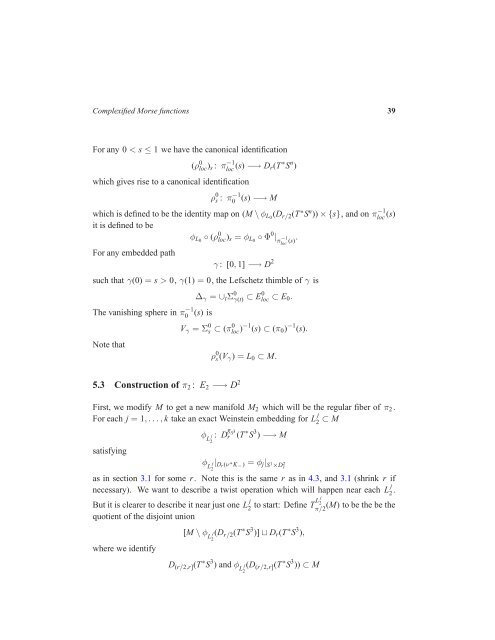The Picard-Lefschetz theory of complexified Morse functions 1 ...
The Picard-Lefschetz theory of complexified Morse functions 1 ...
The Picard-Lefschetz theory of complexified Morse functions 1 ...
You also want an ePaper? Increase the reach of your titles
YUMPU automatically turns print PDFs into web optimized ePapers that Google loves.
Complexified <strong>Morse</strong> <strong>functions</strong> 39<br />
For any 0 < s ≤ 1 we have the canonical identification<br />
(ρ 0 loc)s : π −1<br />
loc (s) −→ Dr(T ∗ S n )<br />
which gives rise to a canonical identification<br />
ρ 0 s : π −1<br />
0 (s) −→ M<br />
which is defined to be the identity map on (M \ φL0 (D r/2(T ∗ S n )) × {s}, and on π −1<br />
loc (s)<br />
it is defined to be<br />
For any embedded path<br />
φL0 ◦ (ρ0 loc)s = φL0 ◦ Φ0 | π −1<br />
loc (s).<br />
γ : [0, 1] −→ D 2<br />
such that γ(0) = s > 0, γ(1) = 0, the <strong>Lefschetz</strong> thimble <strong>of</strong> γ is<br />
<strong>The</strong> vanishing sphere in π −1<br />
0 (s) is<br />
Note that<br />
5.3 Construction <strong>of</strong> π2 : E2 −→ D 2<br />
∆γ = ∪tΣ 0 γ(t) ⊂ E 0 loc ⊂ E0.<br />
Vγ = Σ 0 s ⊂ (π 0 loc )−1 (s) ⊂ (π0) −1 (s).<br />
ρ 0 s (Vγ) = L0 ⊂ M.<br />
First, we modify M to get a new manifold M2 which will be the regular fiber <strong>of</strong> π2.<br />
For each j = 1,... , k take an exact Weinstein embedding for L j<br />
2 ⊂ M<br />
satisfying<br />
φ j : D L2 gS3 r (T ∗ S 3 ) −→ M<br />
φ j|Dr(ν<br />
L2 ∗K−) = φj| S1 ×D2 r<br />
as in section 3.1 for some r. Note this is the same r as in 4.3, and 3.1 (shrink r if<br />
necessary). We want to describe a twist operation which will happen near each L j<br />
2 .<br />
But it is clearer to describe it near just one L j<br />
2<br />
quotient <strong>of</strong> the disjoint union<br />
where we identify<br />
[M \ φ j(D<br />
L r/2(T<br />
2<br />
∗ S 3 )] ⊔ Dr(T ∗ S 3 ),<br />
D (r/2,r](T ∗ S 3 ) and φ j<br />
L (D (r/2,r](T<br />
2<br />
∗ S 3 )) ⊂ M<br />
j<br />
2<br />
to start: Define TL<br />
π/2 (M) to be the be the
















